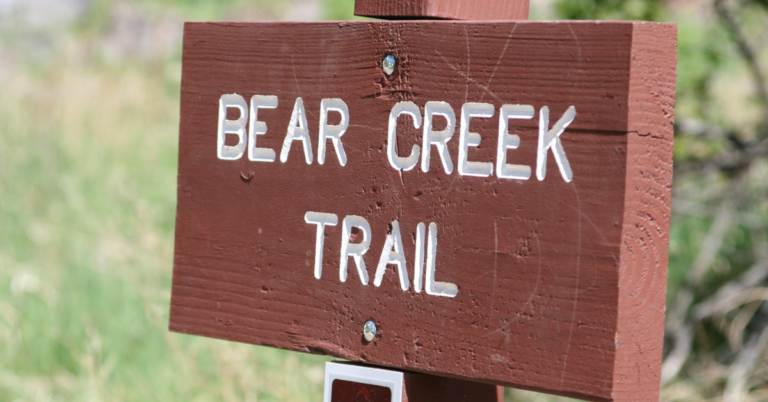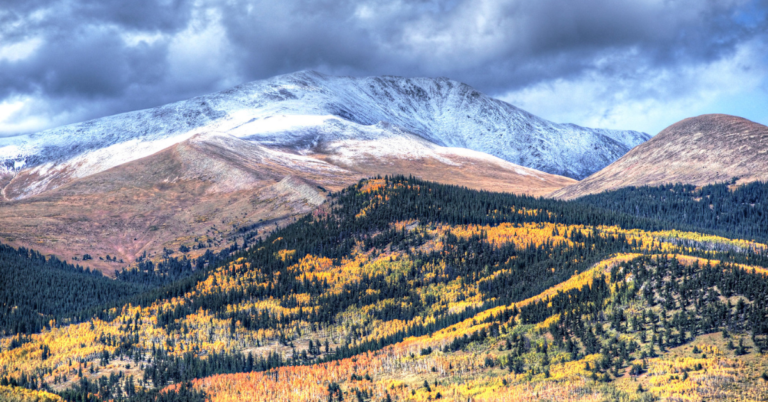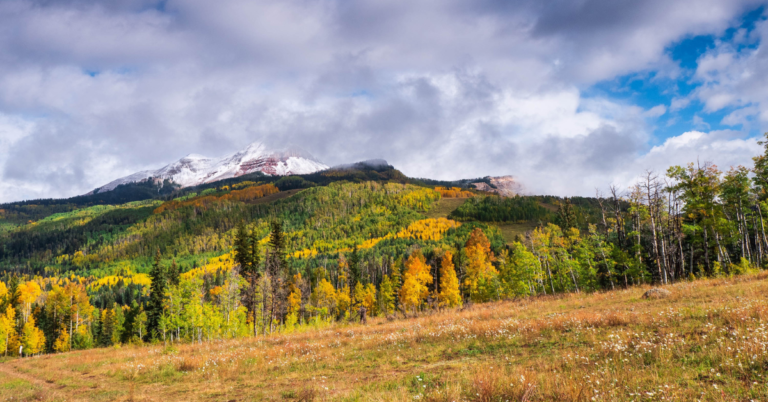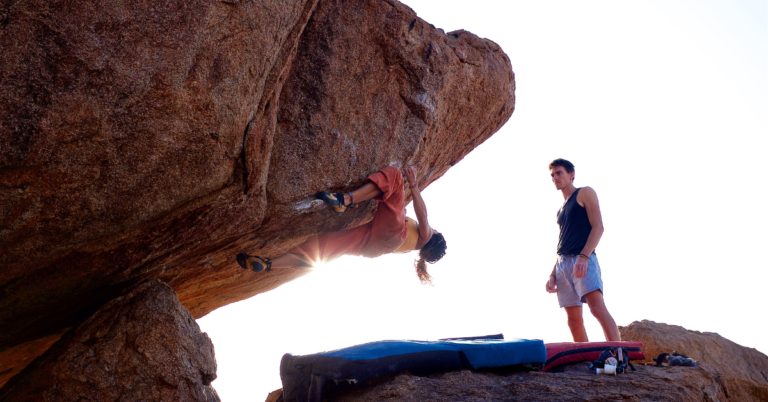Hiking season in Colorado doesn’t have to end when the snow starts falling. There’s a time and place for hot, sunny strolls through the Rocky Mountains, but winter promises something new, majestic, and secluded.
Colorado’s best winter hikes take outdoor fun to the next level. For starters, most people put away their hiking boots until the flowers bloom in the spring—leaving all the wonderful snow-laden trails to you.
Whether you want to summit 14’ers (14,000-feet or higher mountains), glissade down glaciers, or tip-toe across frozen lakes, there’s a little bit of outdoor something-something for any warm-blooded Colorado adventurer looking for things to do in Colorado’s winter season. You just have to be willing to put on your thick gloves, pull up your wool socks, and don your puffy jacket.
Ready to discover the best winter hikes in Colorado? Pour some hot chocolate, sit back, and soak in the inspiration. You’re about to find your next favorite hike.
10 Best Winter Hikes in Colorado
1. Emerald Lake to Haiyaha Lakes Loop, Rocky Mountain National Park
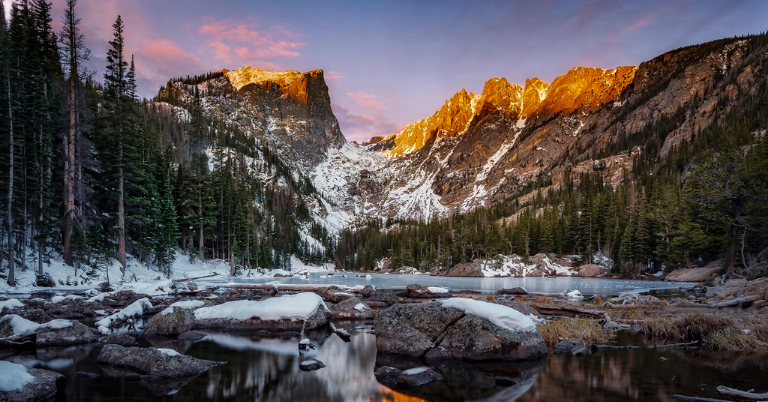
This has to be one of the best winter hikes in Rocky Mountain National Park. Stroll to some of Rocky Mountain National Park’s most iconic lakes across layers of powder. Unless you’ve come right after a storm, you’ll find the connecting trails snow-packed, meaning all you’ll need is a pair of sturdy boots and microspikes.
Along the way, you’ll also get to visit Nymph Lake and Dream Lake. Depending on the route you choose, you could also meander by Loch Lake and Alberta Falls. No matter which path you choose, this winter hike in Rocky Mountain National Park will get you the most bang for your buck.
In the summertime, you’ll be lucky to get a parking spot. During the winter, you’ll likely get prime parking at the Bear Lake parking lot—regardless of if you get there at 8am or 1pm.
2. Quandry Peak, Breckenridge
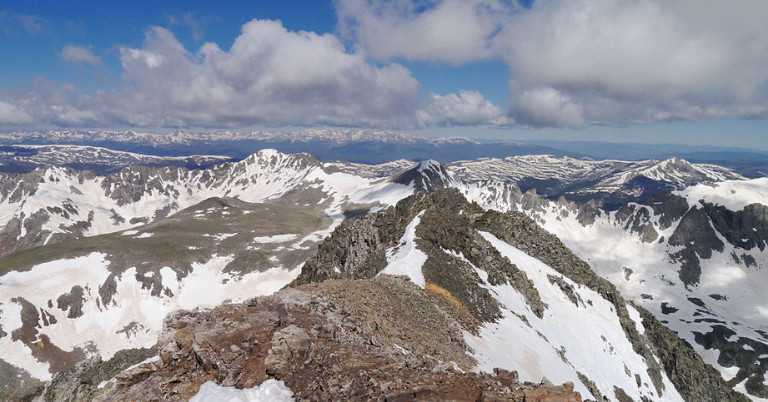
Let’s kick things up a notch. If you’re a peakbagger with a taste for adventure, there’s no better winter beginner 14’er summit than Quandry Peak. While there’s always a risk of avalanche in the snowy season, this peak really only has one hazard zone to watch out for—besides that, it’s smooth hiking.
Well, relative for a 14’er, that is.
This winter hike will push your cardio capabilities to the max. Winter conditions make for slow going, and that means you’ll be exposed to the altitude and weather longer—be prepared. Bring the right gear, communication devices, and provisions for a long day. Keep your eye on the forecasts and the clouds to avoid getting caught in a tricky situation.
All that aside—Quandry Peak is the best Colorado winter hike if you’re looking for your first winter 14’er.
3. Alderfer/Three Sisters Park, Evergreen
Alderfer/Three Sisters Park lies among the forest and mountains in the heart of Evergreen. It’s chockful of beginner-friendly terrain that’s perfect for an outdoor winter outing without any severe risk of avalanche danger.
Want a challenge in elevation? Climb up Evergreen Mountain. Looking for a more casual winter hike? Make your way up to Brother’s Lookout and the Three Sisters loop. Beyond that, there are dozens of variations you could make to keep your hikes fresh and exciting.
Winter weather here can fluctuate widely, so bring a variety of gear to combat the conditions. Microspikes are a must, but you might want to bring a pair of snowshoes if there’s been a recent storm.
4. Saint Mary’s Glacier, Idaho Springs
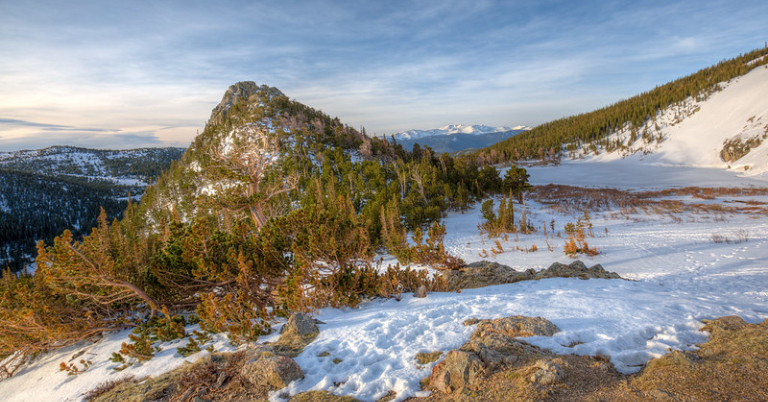
Saint Mary’s Glacier delivers a winter alpine treat without too much work. You can reach the trailhead with just a short drive from Idaho Springs, and then you have about 1 mile of hiking before you reach the glacier.
Strap on your microspikes (and maybe bring an ice ax) and make your way up the glacier. This is excellent terrain for practicing your glissading skills (on your butt or feet) since the grade isn’t too extreme. Plus, it’s a glacier, so you don’t need to worry about falling in a crevasse or being stranded by moving ice.
Colorado contains 14 named glaciers (all in the Front Range), so take advantage of these wonders before they’re gone. Sobering, I know, but that’s how it is.
5. Devil’s Backbone, Loveland
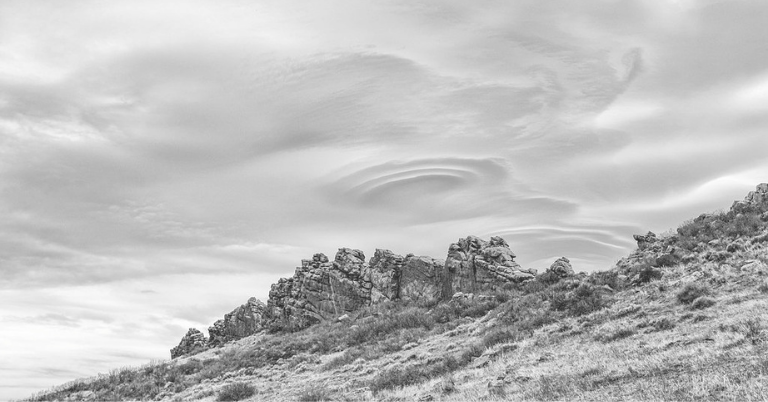
Devil’s Backbone is fun to explore in the winter, especially because the weather deters the crowds. Ever tried visiting this place on a weekend in August? Good luck finding parking.
Plus, mountain bikers usually dominate these trails during the spring and summer—and for good reason. However, in the winter, you can enjoy a bit more solitude and don’t have to worry about looking over your shoulder every 30 seconds.
You can make this winter hike as short or as long as you like. Devil’s Backbone connects to Rimrock Open Space and Horsetooth Mountain Open Space, giving you limitless variations.
6. Royal Arch, Boulder
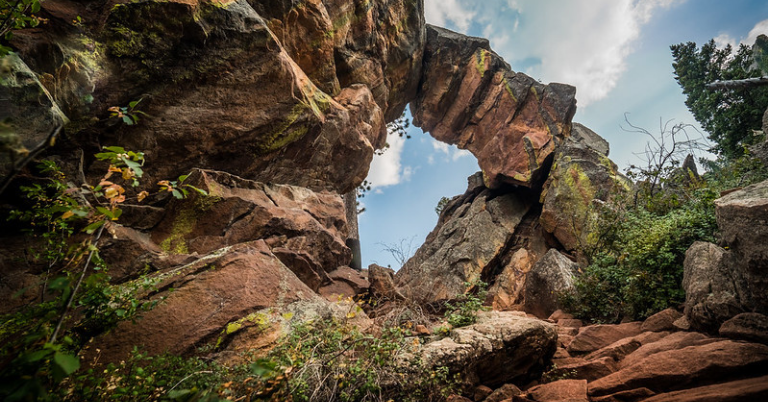
Boulder has hundreds of trails to choose from, but Royal Arch is one of the best winter choices. You’ll experience a fair bit of up and down, but the amazing arch and views from the end are well worth the journey—especially when everything is covered in a layer of snow.
Bring microspikes for this trip. Boulder’s outdoor culture gets these trail packed pretty quickly, so you’ll likely be dealing with slick conditions. Once you’re finished hiking the Royal Arch trail, feel free to jump on any of the other dozen trails to explore further or create a loop.
7. Smuggler Mountain, Aspen
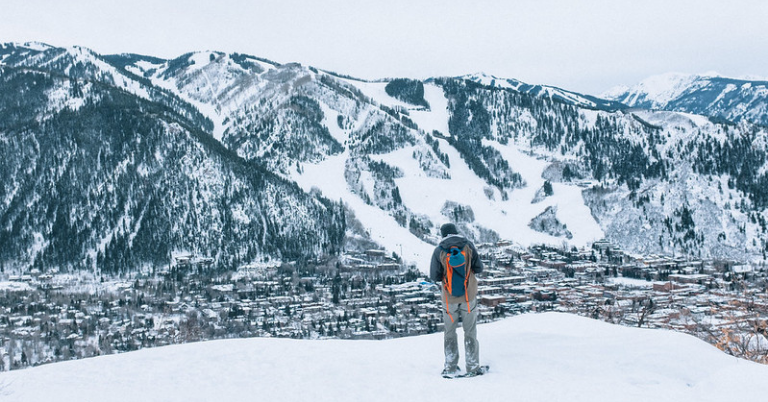
Smuggler Mountain is a zoo in the summertime, but you’ll find a little bit more solitude in the snowy season—most people are out skiing one of Aspen’s 4 ski areas, anyways.
This is a local’s favorite, so you’ll likely find a nice snow-packed trail for your hike. You’ll gain close to 800 feet in less than 1.5 miles, so expect to work up a sweat. Avoid going on the weekends, and you’ll see far fewer people.
8. Purgatory Trail, Durango
Purgatory Trail (also known as Purg Flats Trail) is an 8-mile out-and-back Colorado winter hike. Consider bringing a pair of snowshoes for this one because it’s not a well-trafficked hike in the offseason.
You’ll pass cute little fishing ponds, quaking aspens, and small waterfalls. You’ll even cross a creek shortly into your hike—which will hopefully be frozen over.
The Purgatory Trail is also the popular way to access Chicago Basin and its resident 14’ers (especially if you don’t want to take the train), but those are probably best left until summer weather.
9. Lake Isabelle, Indian Peaks Wilderness
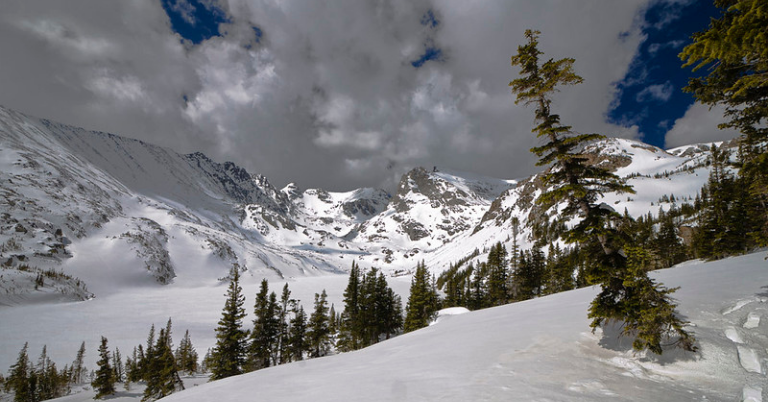
Brainard Lake State Park is ridiculously crowded in the summer, but there’s a good chance you might not have the trail to yourself in the winter. That’s primarily because the access road to the park stops miles away from the usual parking spots.
Strap on your cross-country skis or bring a pair of snowshoes because there’s a good chance you’ll be breaking trail or at least fording through decent amounts of snow. My first time making this trek, I didn’t see another soul until I returned to the road connecting Brainard Lake with the winter parking lot.
10. Perimeter Trail, Ouray
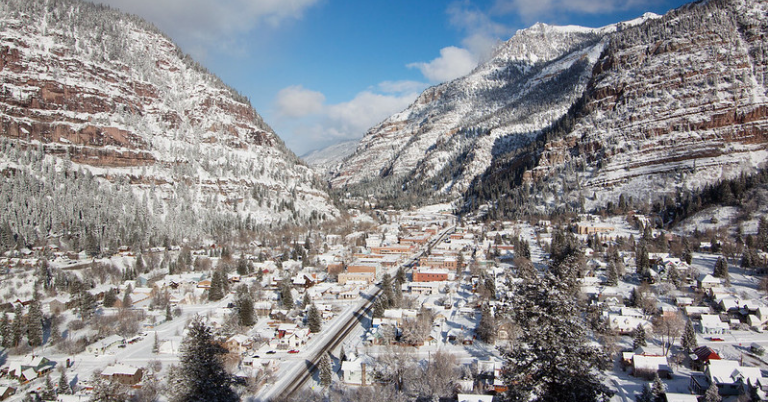
The Perimeter Trail in Ouray is a year-round delight, but it’s best experienced in the winter. December through March, you could hike the whole thing and not see another human. You’ll pass frozen waterfalls, Box Canyon’s Falls still-raging waterfall, the Ouray Ice Park, and snow-topped pine trees.
All the while, you’ll get to enjoy views of snow-capped peaks—regardless of where you are on the trail. Look one way, and you’ll see Whitehouse Mountain and Twin Peaks, look around, and you’ll see Hayden and Mount Abrams, and turn around, and you’ll see the Amphitheater. Rest assured, this is an unforgettable Colorado winter hike.
Gear for Colorado Winter Hikes
Winter hikes in Colorado require a different gear set. Your Chacos and tank tops obviously aren’t going to cut it. For starters, you’ll need layers (think long sleeve shirt, fleece, puffy, and hardshell) of warm clothing and waterproof footwear.
You probably don’t need me to teach you how to dress—you’ll learn through trial and error. I recommend sticking close to home when you first experiment with winter outings. That way, you can test and see which pieces of gear work without ruining your entire day (and potentially risking your life) deep in the mountains.
Each person is different, so don’t just rely on what your best friend or mother tells you. Some hikers might just need a thin pair of knit gloves, while others may need bulky ski gloves.
Winter Clothes
This looks different for everyone, and the weather will change what you need to bring. For example, on a bluebird day in the mountains, you might just need a jacket and sunscreen. However, on the same mountain the next day, you might need a thermal, fleece, puffy, and hardshell—you never know.
The topic of what winter clothes to wear is a full article (and perhaps book) unto itself. I’ll get around to that eventually, but in short—it’s always better to bring more than less. You can always take off layers and stuff them in your pack.
Microspikes
Microspikes are easy-to-attach chains of tiny spikes that you can put on the bottom of your shoe. They’re quick to put on and can be worn with just about any trail runner or hiking boot. They’ll give you fantastic traction on slick, snow-packed trails or even ice.
Snowshoes
Snowshoes are best worn when wading through deep snow on flat or low-angle terrain—these suckers will keep you from post-holing up to your knee. They’re not that great on ice, and they’re a waste of energy on snow-packed trails.
Crampons
When ascending steep or vertical snowy terrain, crampons are the go-to choice. You can wear different crampons with hiking boots, trail runners, or mountaineering boots. They feature long, sharp teeth on the front and bottom that bite into the ice and give you bomber traction.
Ice Ax
When traversing steep terrain, it’s best to carry an ice ax with you. Use it to self-arrest in case you slip and begin sliding. These universal tools can also be used for chopping steps and creating anchors for belaying—but make sure you get trained (on easy terrain) before relying on an ice ax.
Avalanche Kit
If you travel into the winter backcountry, bringing avalanche safety gear is always a good idea. This includes a beacon, probe, and shovel (at a bare minimum). Learn how to use these before hiking in terrain with avalanche risk.
Satellite Phone
A satellite phone is a must-have hiking item, especially if you like to voyage out on your own (and who doesn’t like that?). You can use a satellite phone to communicate when you don’t have service and to signal help in case of an emergency.
Want Something Besides a Hike?
Colorado winter hikes are great, but they’re not for everyone. If you’re looking for a different kind of adventure, you’re in luck—there are plenty of outdoor Colorado winter activities.
Learn about everything there is to do (from skijoring to backcountry skiing to dog sledding) in our article: 19 Must-Try Things to Do in Colorado’s Winter Season.

